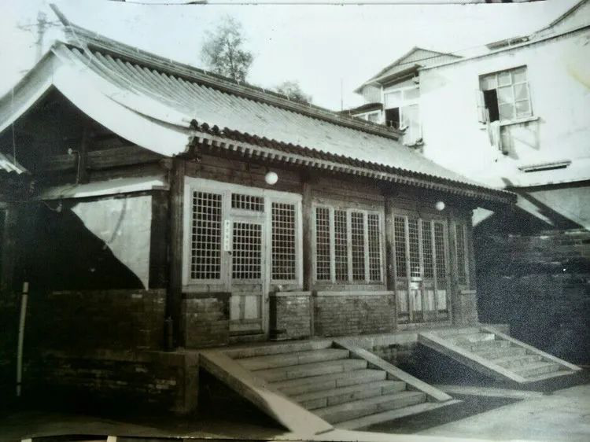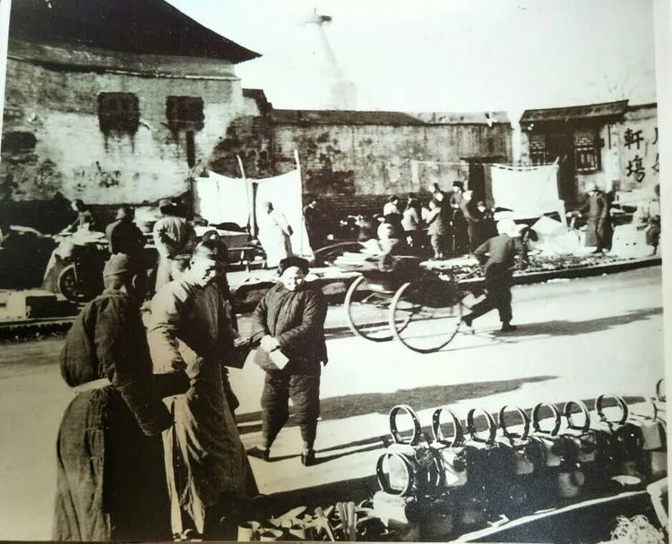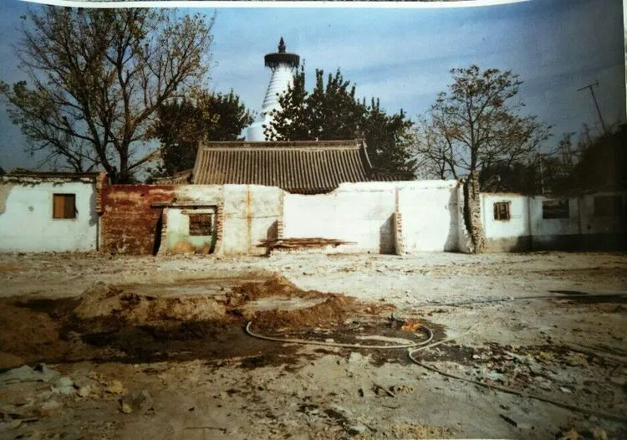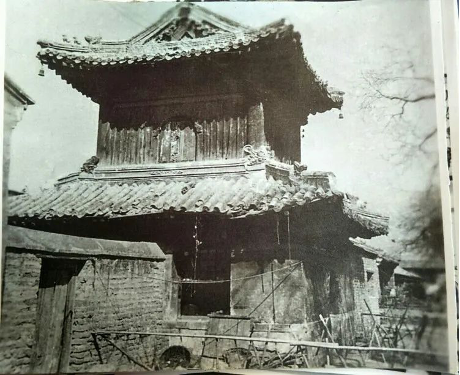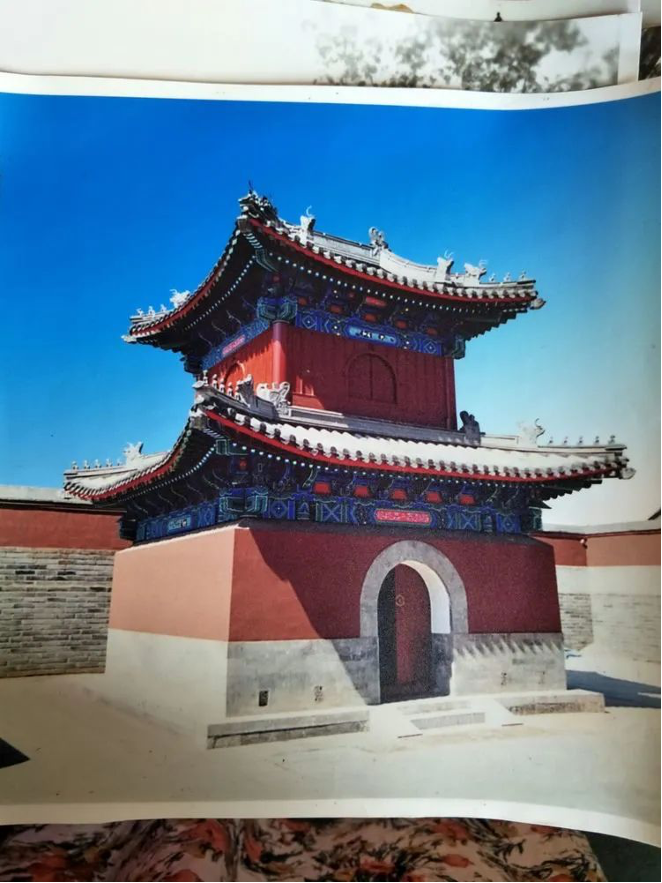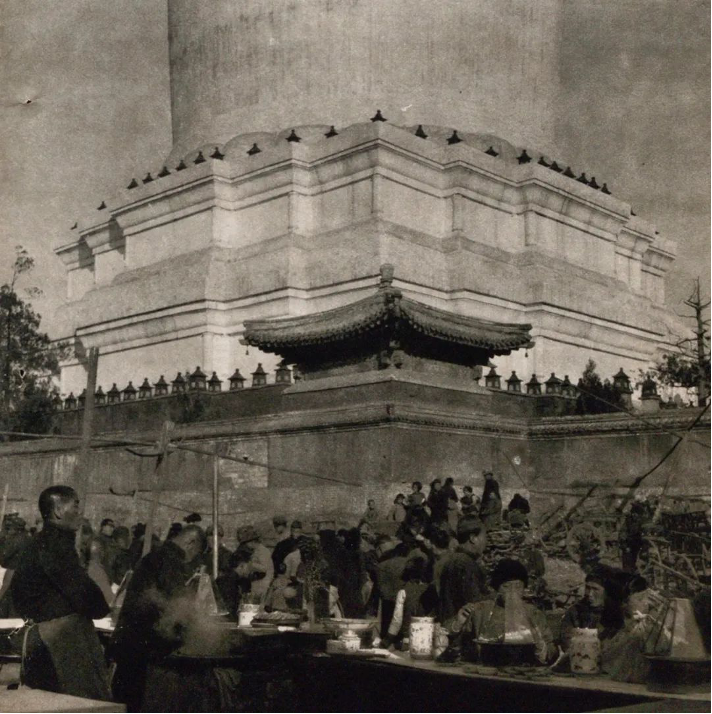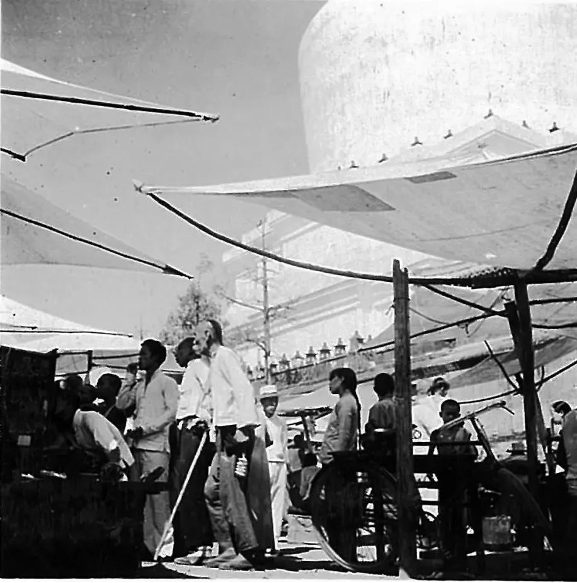I said, "I grew up in Beijing, but I haven't been to Baita Temple in 60 years." This sentence aroused his emotion.
He said that many old Beijingers told him this. He lived in the Nuomi Warehouse when he was young, and there was a Zhihua Temple (智化寺) next to him. It was the home of the eunuch. When I was young, there were temples all over the place, many of which were tattered, and some of them were still inhabited by monks. Later, these temples gradually disappeared, most of them were demolished, and many were smashed during the Cultural Revolution.
I sighed again, but unfortunately; I can no longer see the old photos of Baita Temple. He said he had some pictures and immediately took out dozens of them."
These old photos below are the pictures he took out
These old photos are from the Qing Dynasty, the Republic of China, and the early days of liberation. It can be seen that temple fairs happened frequently in the temple in the past, and common people would go to the temple to listen to the scriptures, and they could also see the houses that were built privately in the temple.
The photo is a photo from someone else's exhibition a long time ago. I don't want it anymore. He thinks the content in the photo is very interesting. It's a pity to throw it away. So he dismantled the photo frames, and gave a dozens of them to a girl, while the rest were stored here. If there are visitors who are particularly interested in Baita Temple, he will bring them out and share them with everyone.
These old photos are from the Qing Dynasty, the Republic of China, and the early days of liberation. It can be seen that temple fairs happened frequently in the temple in the past, and common people would go to the temple to listen to the scriptures, and they could also see the houses that were built privately in the temple.
The photo is a photo from someone else's exhibition a long time ago. I don't want it anymore. He thinks the content in the photo is very interesting. It's a pity to throw it away. So he dismantled the photo frames, and gave a dozens of them to a girl, while the rest were stored here. If there are visitors who are particularly interested in Baita Temple, he will bring them out and share them with everyone.
The courtyard of Baita Temple was once filled with houses and sheds. He said that a resident who had built a shed in Baita Temple once returned to Baita Temple to take a look, and the old man showed him the photos. He recognized the woman in the photo below.
From these privately built houses, you can still see the top of the temple hall. These chaotic houses inside and outside the temple were not cleaned up until 2001.
My brother also told me that there was a temple fair in Baita Temple for a while. I checked and found that in the middle and late Qing Dynasty, the monks in the temple rented out the side hall and the open space, and gradually evolved into one of the famous temple fairs in Beijing. Every New Year during festivals, the place becomes very lively, and became a tradition of taking a walk around the White Pagoda on August 8.
According to my brother, this is after liberation, and temple fairs in Baita Temple still existed. I again said, I remember that I couldn't see the temple gate of Baita Temple from the street.
He said, yes, there used to be a non-staple food shop in front of the temple gate. In the photo below, in 1998, the non-staple food shop that was built randomly at the gate of Baita Mountain gate during the "Cultural Revolution" was demolished. This one shows the non-staple food. The scene of the store being demolished in half.
When I came back and checked, it turned out that after the Cultural Revolution began, the lamas in the temple were dismissed, the gate and the bell and drum towers were demolished and converted into shopping malls, and other places in the temple were also occupied by government agencies, and a large number of cultural relics were lost or damaged.

People go to the temple to listen to the scriptures
These two photos show the before and after restoration of the clock tower
This is probably how I saw Baita Temple when I was a child
This photo shows that there were originally many iron lanterns under the belly of the White Pagoda. But I haven't seen those iron lanterns on the tower. The old man said that the iron lanterns are scattered in the courtyard now.
I suddenly remembered a story I read a few years ago. It was said that when the White Pagoda was overhauled in 1978, due to the impact of the Tangshan earthquake, the spires of the White Pagoda were tilted, and emergency repairs were necessary. It was during that repair that the construction workers discovered that there was a letter hidden under the masonry on the top of the Baita Pagoda, which was written by a worker during the repair in 1937, worried about the Japanese occupation of Beijing. The old man said yes, he also knew about it, it seems that the letter is now in the National Museum.
What happened is this: When the White Pagoda was repaired in 1978, a yellowed raw edge paper was found in the gap at the top of the pagoda. On the paper was written: "The reconstruction of this tower this year coincides with the Sino-Japanese War. On June 29, the Japanese army occupied Peiping, and the war spread throughout the country.
Airplanes and artillery bombarded everywhere, and life was devastated. Robbery, murder, rape and rape were everywhere, and the dead of soldiers and civilians were invincible. Within a few months, Japan actually occupied North China, and the war in several provinces was still fierce. It was impossible to predict when the war will end, and it is difficult to determine the rise and fall of a country. Climbing the ancient pagoda recalls the past and recalls the present, and feels alive! A few words are briefly described to inform future generations as a permanent memorial. In the twenty-sixth year of the Republic of China, on October 3rd, Luo Jun".
Baita Temple is under renovation
Author: FANG
Market life under the White Tower


The White Pagoda, standing in the Fucheng Gate of Beijing, is the only existing Yuan Dynasty building in the urban area of Beijing. During the more than 700 years that accompanied the White Pagoda Day and night, the real name of the temple in front of the pagoda was rarely known, and it was habitually called the White Pagoda Temple (Bái tǎ sì).
The history of Baita Temple can be traced back to Yong'an Temple (永安寺) built during the reign of Shouchang in Liaoning Province. The monastery was destroyed by war at the end of the Jin Dynasty and the beginning of the Yuan Dynasty, and only one Sakyamuni stupa survived. In order to preserve the relic and pray for the newly built Dadu (大都), Kublai Khan decided to build a new pagoda on the original site under the auspices of Nepali craftsman Araniko. After its completion, the White Pagoda became the tallest building in the city at that time, forming a magnificent scene of "Jincheng Jade Pagoda" with the metropolis.
In the year when Emperor Yuanshun was defeated and went to Mobei(漠北), the "Dashengshou Wan'an Temple"(大圣寿万安寺) was burned down by thunder and fire, and only the White Pagoda survived. The Ming Dynasty rebuilt the temple in front of the tower and renamed it Miaoying Temple, which is less than one-eighth the size of the Yuan Dynasty. During the Qing Dynasty, Miaoying Temple became a lama temple.
In 1937, the Old City Cultural Relics Arrangement Committee raised funds to repair the White Pagoda. In May 1938, Tibet Anqin Rinpoche (安钦活佛) was specially invited to hold a three-day consecration ceremony. During this period, a colorful archway was built in front of the mountain gate of Baita Temple.



At the end of the Qing Dynasty, many temples began to hold temple fairs to subsidize their livelihoods through investment promotion and rent collection. Baita Temple is no exception. The market opened on the fifth or sixth day, and it opens six days a month. Later, together with Huguo Temple (护国寺), Longfu Temple (隆福寺), Tudi Temple (土地庙) and Huashi Temple Fair (花市庙会), it was called the "Five Temple Fairs" in Beijing during the Republic of China.
According to "Investigation of Peking Temple Fairs, History of Temple Fairs" (published by Peking National College in May 1937), it is recorded: "The earliest temple fair in Peking, as we know it today, should be the spring outing of Liao's 'Shangsi'." Among the "Five Temple Fairs" (五大庙会) ,only Baita Temple was built in the Liao Dynasty. Can it be inferred from this citation that the Baita Temple would have arisen in the Liao Dynasty? This remains to be verified by experts and scholars.
In fact, to be precise, the Baita Temple fair should be regarded as a temple market. Because, when it opened, there were no religious activities in the temple, and tourists did not worship the Buddha, but purely for shopping entertainment. In the "Peking Temple Fair Survey"(《北平庙会调查》), the Baita Temple covers an area of 1,600 abbot, with 240 abbots in the temple and 700 abbot outside, making it 940 abbot in total. It ranked third in the "Five Temple Fairs", with a total of 735 gathering stalls, second only to Longfu Temple(隆福寺).
"World Journal" (世界日报) in 1926 described the scene of Baita Temple during the Republic of China: "People who have lived in Beijing for a long time do not know Baita Temple. Baita Temple is located on Pingzemen(平则门) (now Fuchengmen) Street, but people who want to find Baita Temple, the name of the temple is impossible to find, because the original name of Baita Temple is Miaoying Temple, and there is a huge white pagoda in the backyard, named after the pagoda, commonly known as Baita Temple. The interior of Baita Temple can be divided into three parts: one It is a juggling arena, among which Wanfutang (万福堂)dance performances and Hou Wude's Laoting drums are the most popular. The second is the goods pusher, which sells a complete range of everything, and the price is slightly cheaper than that of the store The third is the Lama Teahouse. There are four or five teahouses, each with six water coins and tea leaves, but it is limited to not sell female customers. It was called “Lama tea” because it was opened by lamas.
The middle courtyard, which gathers various cultural and entertainment performances, is the liveliest place in the temple fair. Those who sing drums, those who play foreign films, those who speak cross talk, and those who play big swords are temporarily surrounded by curtains, each occupying one side.
Fu Shiting's Laoting drum and "Little Bee"'s funny drum were very famous. Those who sang small operas, surrounded them with cloth, and then performed them inside, and those who received money at the entrance shouted while receiving: "Five cents to watch two plays, "Sanniang's Godson"(《三娘教子》) and "Empty City Strategy"(《空城计》). "Here, ordinary people can spend a few cents and have a good time.
The open space to the north of the pagoda is full of stalls for character measurement, face-to-face and fortune-telling. The stall owners use strange costumes to attract customers. Among them, there is a "Tan Xiang Niu Letian" (谈相牛乐天)hexagram with the highest gold: one yuan for rough talk and two yuan for detailed explanation. Some people think that "cheap is not good, and good is not cheap." They would rather pay more than listen to his "God blows". In some other open fields across the courtyard, there are juggling, pulling hard bows, playing monkeys and playing with birds, and renting books for children.
From 1958, the Baita Temple’s crowd gradually decline. In 1997, the Beijing Municipal Government put forward the slogan "Open the mountain gate and reveal the White Pagoda"(“打开山门,亮出白塔”), demolished the shopping mall, and rebuilt the mountain gate and temple buildings. Today, the White Pagoda stands in the temple, majestic and majestic, but no temple fairs are held anymore. With the exploration and implementation of the "White Pagoda Regeneration Plan" (白塔寺再生计划)in recent years, the hutongs under the White Pagoda underwent subtle renewal through the innovation and design of architects. The market life under the White started booming in the increasingly strong style of the ancient capital.
Photo / Luo Dongsheng
** This is the third part of our series on the cultural history of Bai ta temple (or Miaoying temple). The first and second part can be accessed here: Part 1, Part 2.
**The link to the original article can be accessed here
[Please note: If you are interested to reproduce our translation works, please let us know in advance. Contact us: thearanikoproject@gmail.com for inquiries]





